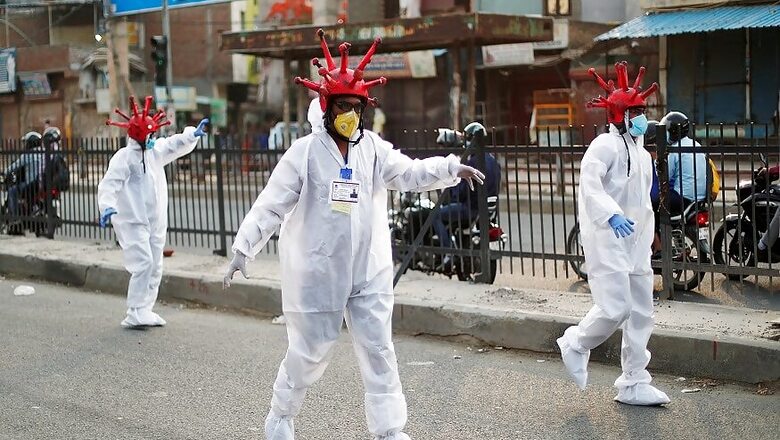
views
New Delhi: India will now be under lockdown till May 17 with a complete ban on air travel, trains and inter-state road transport for the general public while educational institutions, theatres, malls, hotels and bars will also remain shut, the government announced on Friday. However, it gave some relaxations for various business activities and people's movement within areas with limited or no COVID-19 cases.
The decision to extend the lockdown by two more weeks after May 3, when the second phase of these restrictions was scheduled to end, came after a continuous rise in the number of people testing positive for the infection across various states, including in major metropolitan cities, with the nationwide tally crossing 37,000. The death toll has crossed 1,200.
Prime Minister Narendra Modi had first announced a 21-day lockdown from March 25, which was later extended by two more weeks to contain the virus spread. However, several experts have cautioned that the lockdown is severely impacting economy and many rating agencies and industry bodies have forecast a sharp dip in the country's economic growth rate for the current fiscal, with a few even estimating an overall GDP decline.
All major urban centres, including Delhi and Mumbai, have been identified as 'red zones' or areas with large numbers of cases -- hence not many relaxations would be applicable to them beyond the already permitted ones for those involved in essential services.
Special trains also began operating on Friday, which also happened to be Labour Day, to help lakhs of migrant workers stranded for over a month at various urban centres.
The Ministry of Home Affairs (MHA) said the lockdown measures so far have led to "significant gains" in the COVID-19 situation and some activities will remain prohibited throughout the country, irrespective of the zone. These include air travel, rail, metro and inter-state movement by road, running of educational and training institutions, hospitality services, cinema halls, malls, gymnasiums and sports complexes.
All social, political, cultural and other kinds of gatherings and religious places or places of worship for public will also remain shut, as per an order issued by the MHA.
Outside the containment zone falling within red zones, certain more activities will be prohibited and these include plying of cycle rickshaws and auto-rickshaws, running of taxis and cab aggregators, intra-district and inter district plying of buses, as also barber shops, spas and saloons.
Activities allowed in red zones with restrictions would include movement of individuals and vehicles for permitted activities, with a maximum of two persons (besides the driver) in four-wheelers and with no pillion rider in two-wheelers.
Industrial establishments in urban areas, including Special Economic Zones (SEZs), Export Oriented Units (EOUs), industrial estates and industrial townships with access control, have been permitted.
Construction activities in urban areas will be limited to in-situ construction (where workers are available on site and none are required to be brought in from outside) and construction of renewable energy projects.
Shops in urban areas, for non-essential goods, are not allowed in malls, markets and market complexes. However, all standalone shops, neighbourhood shops and shops in residential complexes are permitted to remain open in urban areas, without any distinction of essential and non-essential.
E-commerce activities in red zones are permitted only for essential goods. Private offices can operate with up to 33% strength as per requirement, with the remaining persons working from home.
All government offices can function with senior officers of the level of Deputy Secretary and above at full strength, and up to one-third of remaining staff.
Commercial and private establishments allowed in red zones include print and electronic media, IT and IT-enabled services, data and call centres, cold storage and warehousing services, private security and facility management services, and services provided by self-employed persons, except for barbers.
In orange zones, taxis and cab aggregators will also be permitted with one driver and one passenger only, while inter-district movement of individuals and vehicles will be allowed for permitted activities only. Four-wheeler vehicles will have maximum two passengers besides the driver and pillion riding will be allowed on two-wheelers.
In green zones, all activities are permitted except those prohibited throughout the country irrespective of the zone. However, buses and bus depots can operate with maximum 50% capacity.
The MHA earlier on Friday listed 130 districts in the country in red zone, 284 in orange zone and 319 in green zone. This classification is to be followed by states and Union Territories till May 10 and will be revised on a weekly basis or earlier if required,
Major cities like Mumbai, Delhi, Kolkata, Hyderabad, Pune, Bengaluru and Ahmedabad have been designated as red zones in the new classification.
A district will be considered under green zone if there has been no confirmed cases of COVID-19 so far or there is no reported case since the last 21 days there. Red zone districts are those considered to be infection 'hotspots', decided on the basis of number of active cases, doubling rate of confirmed cases and extent of testing and surveillance feedback.
Districts which are neither defined as a red or green zone would be considered an orange zone.
(With inputs from PTI)


















Comments
0 comment